|
|
|
|||
|
|
||||
|
|
||||
| The (Jet)X Files | ||||
|
|
HOME | SITE MAP | FORUM | CONTACT |
|
||
|
ABOUT | MOTORS | MODELS | ARCHIVE | HISTORY | STORE | FAQ | LINKS
|
|
|
|
|
|
|||||||||||||||||||||||||||||||||||||||||||||||||||||||||||||||||||||
|
The (Jet)X Files 17
for May 2004
by Roger Simmonds Reprinted from SAM 35 Speaks, May 2004 Afterburning Last month’s discussion of Jetex and Rapier motors’ performance generated some reflections on how Jetex motors were originally measured. If you look carefully at the picture of Peter Cock in April’s column you will see the original Wilmot Mansour & Co. thrust rig on the bench next to him. A diagram of this apparatus (which was also used by R H Warring for his ‘independent’ tests) appeared in the Aeromodeller, Nov. 1953. |
|
|||||||||||||||||||||||||||||||||||||||||||||||||||||||||||||||||||||
|
RHW described it thus: “The principle of operation is very simple.
The Jetex unit is clamped to a suitable carriage suspended from knife edges
… [this] bears against the vertical leg of an inverted “T”
… pressure against this is translated into a vertical plunger bearing
down on a flexible chamber filled with a suitable fluid. The pressure applied
forces fluid into a vertical glass tube. The scale is calibrated by means
of weights applied via a suitable pulley to the carriage.” Bert Judge
recalls that the device was tricky to use; “it was not a true gauge
of the thrust because the carriage didn’t remain horizontal. It had
to be calibrated every time.” The ‘suitable fluid’ was, by
the way, methylated spirits. The real drawback of these devices is that the motor is stationary, and venturi phenomena or the effects of cooling airflow cannot be assessed. At best, and after careful calibration, static thrust rigs give reproducible data that can be used to compare motors, but they provide only an approximate indication of their actual performance in a model at speed. ‘Dynamic’ thrust rigs (with for example, a spinning rotor) give a better indication of the actual performance in flight. Measuring the power of reaction motors thus presents practical and theoretical problems: I do not know how Jan Zigmund calibrates his Rapiers, and Powermax were understandably quite cagey about how they tested their Jet-X range of motors. |

- Aeromodeller, Nov. 1953
|
|||||||||||||||||||||||||||||||||||||||||||||||||||||||||||||||||||||

|
|
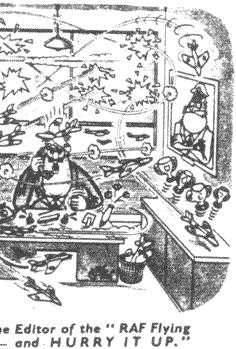
- Royal Air Force Flying Review, May 1954
|
||||||||||||||||||||||||||||||||||||||||||||||||||||||||||||||||||||
|
|
|
|||
|
Continuing my investigations of early Jetex literature, I recently requested,
and received, a copy of “Rockets or Jets”, an editorial from the
May 1948 Aeromodeller. This was the month before the famous ‘Jetex
launch’ issue of June 1948, so this is the first formal reference to
Jetex motors in the Model Press. The preamble refers to ‘European diesels’
and ‘American glow-plugs’, and then states with patriotic pride;
“the pendulum has swung back to its central position, i.e. to this
country, on release of information on the latest developments of a new fuel
and motor giving an effect of jet propulsion. Of course we must not overlook
recording the individual researches of Mr Howard Boys and others in the
way of rocket propulsion”. The English may appear a little dated, and
the editor a little confused about jets and rockets, but the following account
of his Jetex epiphany makes fascinating reading: “Recently, at the
invitation of the Explosives Division of Imperial Chemical Industries Ltd,
we were privileged to fly in a specially chartered plane to Prestwick to
see a first demonstration of these special propulsion units which during
the past few years have been developed for use in model aircraft, model
cars and model boats. The demonstration was most efficiently organised and
convincing. We saw tailless aircraft make powered flights of from twenty
to thirty seconds’ duration … we also saw practical demonstrations
in the laboratory of several sizes of units in which quite constant thrust
output was clearly demonstrated”. It continues in this vein for some
paragraphs, concluding, “We shall watch the introduction and future
development of this latest invention with great interest … be assured
that readers will be kept right up to date with authentic information in
the pages of the Aeromodeller”. There is, in all this verbiage, an
especially tantalising reference; “An interesting feature of this development,
and one which we feel has considerable possibilities, is that the special
fuel can be used equally as well in compressed air motors as in the units
which will be marketed and in which the fuel would normally be consumed”.
Hmm… Does anyone know anything about this motor, which, I believe was
distinct from either the Wilmot Mansour Jetex turbine or the later (1954)
US Dempster ‘Turb-O-Prop’ [see right]? Following April’s discussion of Jetex ‘rockets’, I rediscovered a number of futuristic ‘spaceships (one with two stages) designed by Paul Del Gatto. He was obviously much inspired by the Jetex 50R/50HT motor and conceived some novel applications using combinations of ‘cored’ and unmodified pellets. He wrote, (Model Airplane News, 1956): “Missile-type’ craft with stub wings for safe descent and landing will offer new thrills … ships such as the Lockheed F-104 and even the X-15 are now feasible fliers”. These types of model are now more suited to Estes rockets, and the inventive though fanciful applications of a variously fuelled 50R motor are just not available to Rapier users. We can, however, have fun with ‘missile type’ models, and here are two Del Gatto designs, one for the 50B and the other for the Jetmaster. These dimensions can be modified to suit our own creations for the L4 and the different species of L2. An ‘authentic’ Jetex model would perhaps be even better, and if any reader has a plan, or better still, a kit of the Sebel Viper so that the print wood can be copied I would like to hear from you. |
 “new thrills … for every kind of model plane”
- Air Trails Hobbies for Young Men,
Dec. 1954 (p. 57) |
|||
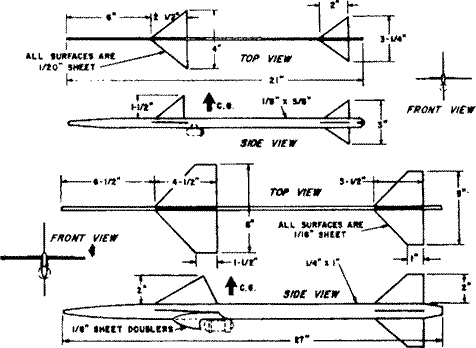 Lastly, I have tracked down a plan of Sigurd Isacson’s Sabre for Jetex 50. This built-up model looks better than either the Keil Kraft or Veron offerings, confirming Sten Persson’s high opinion of Isacson’s designs. If anyone would like a copy, please tell me. Following his Draken, (see last month), Chris Strachan has built a very nice Lansen (his own design rather than Isacson’s) which I hope to discuss next month. Should Chris fancy a Viggen, there is actually an Isacson plan he may consider. True, it is all-sheet, and no more than semi scale, but it is attractive nevertheless, especially if you want respite from all those stringers. A (rather poor) reproduction appeared in ‘Jetex Natters’, SAM Speaks, Feb. ’92 [below]. Has any reader a better copy of this plan? |
|
|||

- SAM 35 Speaks, February 1992 (p. 56)
|
||||
|
|
|
|||
|
Helicopters Reaction powered helicopters were quite popular in the fifties, but they have been all but neglected in the present Vintage Scene, and you have to go back to 1982 to find a discussion of a real live working example in SAM 35 Speaks (see later). The ‘torqueless’ Jetex motors were early recognised as promising power sources for (non ballistic) VTO, and in its report of the 1950 Fairlop Meet, the Aeromodeller refers to the “Fag and Fizz Brigade’s” demonstration of three Jetex helicopters. One of these, the creation of F.G. Boreham [pictured right] and Harold Figgins (who worked with Joe Mansour) had rotors spanning 6' and two Jetex 350 units. It must have made an impressive sight. Professor Boreham’s article, “Jetex Helicopters”, which included his aptly named ‘Simple Helicopter’ design, was published in the next Aeromodeller (AM) (Jan 1951); the archetypal Wilmot Mansour ‘Jeticopter’, designed by Ian Dowsett in liaison with the eccentric boffin became available later that year. The unique feature of Boreham’s designs was the ‘delta hinge’ that allowed efficient contra rotation and extended flight times. Keen competition fliers quickly appropriated this innovation, and the ‘Thurston Cup’ was a hotly contested and popular event at the Northern Heights Gala. Mike Ingram [pictured right] won this three years in succession (1953-1955) with a model powered by two special 200 units. I hope these, which were lighter than the standard units, with aluminium safety valves in lieu of the usual springs, can be made out in the photo of Mike with his three-times contest winner. The UK and US Model Press published a number of articles and not a few plans for duration and sport models at this time. Many are well worth recreating, and if you fancy something a little different, you could try a Rapier L4 in Bob Burgass’ Jetex 100 powered Jet-Gyro autogyro, (AM, Feb. 1953), a design, incidentally, which dates back to 1949. Bill Henderson [pictured right] discussed span loadings, pitch angles and power/weight ratios in an article in the 1953 Frank Zaic Yearbook. He also tabulated rotor spans for different motors, and, pertinent to us Rapier users, a rotor span of 24'' was recommended for the Jetex 50 (˜L2 HP) and 36'' for the Jetex 100 (˜L4). Parnell Schoenky’s well-illustrated helicopter article in the 1954 AM Annual included the plan of his JH-2. This was, uniquely I believe, designed for twin Jetmaster power and had a span of 42''. |
 F.G. Boreham with his twin Jetex 350 helicopter at the 1949 Northern Heights Gala
- Aeromodeller Annual, 1950
 Mike Ingram with his twin Jetex 200 helicopter at the 1953 Northern Heights Gala  Bill Henderson with his twin Jetex 350 'Whirligig' at the 1952 Northern Heights Gala
- Bill's personal collection
|
|||
|
Schoenky, great helicopter enthusiast that he was, also wrote an
article
in Frank Zaic’s 1955-56 Model Aeronautical Yearbook . Here, he paid tribute to earlier
Jetex designs; “the British layout developed by Boreham can hardly
be beat … these skewed-hinge (pitch cone coupled, that is) helicopters
climb well, are highly stable and autorotate so well that they have been
known to pick up risers and soar a bit. They fly well in breezy weather,
once they get started, but don’t do much better than the feathering
rotor in horizontal flight.” |
||||
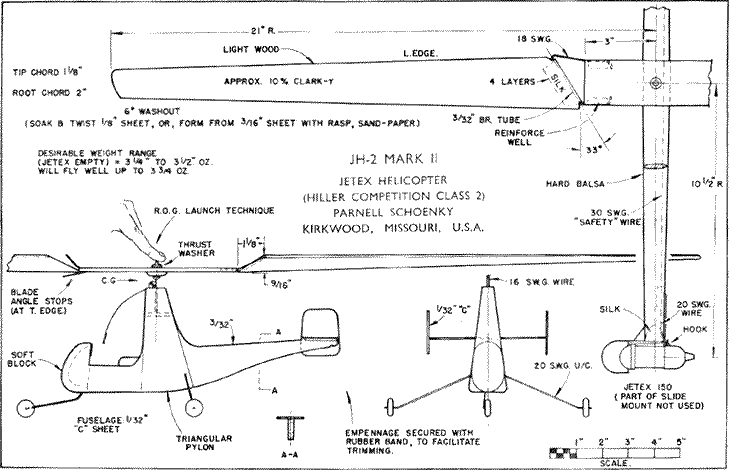
- Aeromodeller Annual, 1954
|
||||
|
As well as the Jeticopter 50 and 100, Wilmot Mansour produced a delightful
ARTF helicopter for twin Jetex
50 power. As can be seen, the prefabrication was extensive (even the
motors were fitted), the instructions were comprehensive, and, best of all,
the fuselage was very reminiscent of the beautiful pre-war FROG offerings.
Mint examples of this splendidly presented model do turn up from time to
time (the example shown comes from Andy Blackwell’s collection) but
they are probably much too precious to fly. Ian Dowsett had a Jeticopter at Canterbury last year, but apart from this we have seen few ‘Jetex’ helicopters, vintage, classic, or otherwise, at meetings for many years. This is a pity, and as an encouragement to potential builders, here is an inspirational description of Mike Wilson’s Jeticopter 50 from SAM Speaks, Nov 1982: “The rotors were allowed to spin up to a fair old rate and the helicopter is released into wind, when it rises to twenty or so feet, at which ceiling it hovers for a time before descending. During flight the fuselage rotates slowly but not excessively”. Very nice. Would it not be good to see jet-propelled helicopters in their element again? Happily, Rapier motors, being lighter than Jetex motors, are actually very suitable as helicopter powerplants. The Jeticopter 50 could easily be converted for twin L2 HP’s (or L2 LT’s if the span was reduced; see Bill Henderson’s article) and the JH-2 would probably be adequately powered by two L4’s. Whilst on the subject of VTO machines, the 1953 AM Annual included an article on “Flying Saucers” by Claude R. De Vries. His Jetex models could very well be powered by Rapiers, and would provide some extra novelty at our Galas. These sorts of models always were a part of the Jetex scene, and I cannot resist sharing an early anecdote from Mike Ingram. The model in question had a rotor enclosed in a light body that was adorned with halves of Ping-Pong balls. Mike recalls: “We made several unofficial Flying Saucers for two Jetex 50B’s, and I demonstrated one for Joe Mansour in the car park. The idea was that you started the two engines and got the saucer going on a bit of piano wire, then withdrew it leaving the saucer flying. I let it go a bit too soon, and it sank to the ground and hovered there a bit, blowing up all the dust. Then it did a complete circuit of Joe’s legs, by which time, when it got round the front, it was on full power and went whoooosh, straight up in front of his face to about a hundred feet. Then of course the motors cut and it just fell out of the sky, tumbling over and over, and landed on the ground”. Mike doesn’t remember Joe’s reaction. |
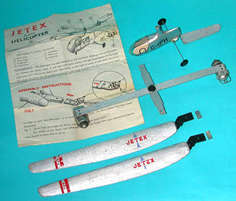
- photo by Andy Blackwell
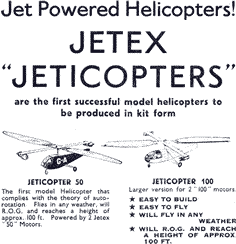 |
|||
|
Con trails The discussion of William Benson Ball (BB) [pictured right] last month produced some very interesting correspondence. First, not only had Mike Parker also been considering an article about him, but also Ron Marking told me that, by an amazing coincidence, he had just reprinted the 1954 Aeromodeller Annual article in the newsletter he edits for the Cornwall Vintage Aeromodellers. Ron was able to include a memoir by a work colleague of BB who knew him in the fifties before his long sojourn in the US. BB made good there, and after a distinguished career in the US Navy, ‘Cdr’ Benson retired to become Chief Designer for a well-known American kit manufacturer. Secondly, Bob Palmer sent me a later article by Cdr William Benson published in the US (Flying Models, Sept. 1974), which complements the sagas previously recorded for posterity in the 1954 Aeromodeller Annual and 1960 Model Aircraft publications. It makes intriguing, if sometimes jaw-dropping, reading. “I had already”, he writes, “developed a reliable solid fuel rocket motor … I mixed guanidine nitrate and other chemicals, then steamed them in stainless steel tubes to concentrate and solidify the mixture. This became my first commercial venture. I sold the idea, and the units became available world wide”. I wonder what Joe Mansour would have said about that? |

- Aeromodeller Annual, 1954 (p.87)
|
|||

A few more details of his first reaction motors (like the X.PJ-16 pulse-jet [below] and the X.RJ-9 aerothermodynamic duct [right]) are given, and he writes: “I also experimented with ducted compressors with fuel burning”, adding, with a measure of understatement, “a rocket booster take-off with radio activated light-up of the ram jet at between 80 and 100 mph is exciting”. All this, remember, was in the late forties and early fifties. |
|
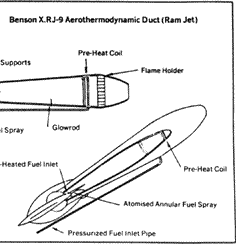
- Flying Models, Sept. 1974
|
||
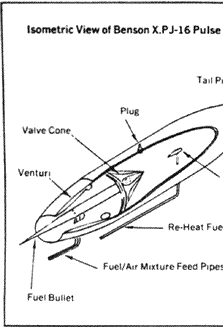
Whatever the truth of some of BB’s stories and the extent of his confabulations, the attractiveness of his early models remains, and ‘recreation’ of these for Rapier power is a worthy aim for the Vintage Modeller. I am less competent to judge whether his various motors are feasible. Above are ‘isometric views’ of a couple of his early powerplants for the assessment of readers more expert than I am in model engineering. |
|
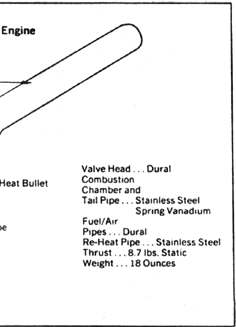
- Flying Models, Sept. 1974
|
||
|
|
|
|
|
|
|
|
Acknowledgements - Article: Roger Simmonds - Illustrations: Roger Simmonds (Warring's rig, Del Gatto's missiles, Mike Ingram, Schoenky's JH-2, Jeticopter ad) Andy Blackwell (Jeticopter) Bob Palmer (Ball's motors) Peter Tolhurst (Isacson's Viggen) MAAC archives via Bill Henderson (Dean's cartoon, Turb-O-Prop, Boreham's helicopter, Ball) Bill Henderson (personal photo) |
|
|
|
|
ABOUT | MOTORS | MODELS | ARCHIVE | HISTORY | STORE | FAQ | LINKS |
|
|
Terms of Use
|
Queries? Corrections? Additions?
Please
contact us.
|
|